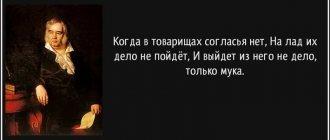About the concepts of introversion and extraversion
Dichonomic concepts in Personality Theory define people's attitudes according to their inclinations to evaluate internal sensations or external events. A person is endowed with a certain set of qualities at birth. Typological affiliation is the basis for the entire period of personality formation.
What is extraversion
Extraversion is a personality’s focus on relationships with the outside world. An extrovert may have a rich inner world, but he can only demonstrate his abilities in interaction with the surrounding society.
Extroverts do not tend to take a long time to understand their feelings; they quickly navigate the situation. People of this psychotype do not hesitate to make decisions, but are capable of radically changing their attitudes under the influence of the environment.
What is introversion
Introversion in psychology is a number of personal characteristics of an individual that are aimed at avoiding social contacts. A person with this orientation is focused on the mental activity of his inner self. The accumulation of energy during introversion occurs inside a person.
Introversion is the ability to control your feelings and plan your actions. Introverts take a long time to make decisions, but for them they become the only and unshakable ones.
Concepts
Carl Jung considered the main criterion distinguishing extroverts and introverts to be “the direction of libido movement.” According to Jung, extraversion is manifested in the direction of a person’s libido (vital energy) towards the outside world, in the fact that the extrovert prefers social and practical aspects of life, operations with real external objects, and the introvert prefers immersion in the world of imagination and reflection. An extrovert is aimed at wasting his own energy, moving it towards surrounding objects, an introvert is aimed at accumulating, moving energy into the inner world. Introversion is one of the archetypal manifestations of the collective unconscious. Analyzing the differences in the concepts of two other prominent representatives of dynamic psychology, Sigmund Freud and Alfred Adler, Jung believes that the essentially similar concepts of these authors differ due to the different fidelity of their authors. If the first, according to Jung, is an introvert, which forces him to look for the mechanisms of the psyche in the depths of the inner world, then the second, being an extrovert, considers the human psyche in a social context, considering the desire for social superiority as the basis of libido.
Hans Eysenck borrows the term “extraversion” from Jung when creating his dispositional model. Eysenck found that across different studies conducted by different research groups, personality dimensions varied consistently in the degree to which they were oriented towards social relationships as opposed to being oriented toward reflection, experiences, and feelings. These concepts are the poles of a superfactor - a complex of personality traits that correlate with each other, which is determined genetically. A typical extrovert, according to Eysenck, is sociable, optimistic, impulsive, has a wide circle of acquaintances and poor control over emotions and feelings. A typical introvert is calm, shy, distant from everyone except close people, plans his actions in advance, loves order in everything and keeps his feelings under strict control. The Jungian term came in handy in this situation. Moreover, it turns out that extraversion may be one of the basic personality traits, of which Eysenck eventually identified three.
In psychiatry, the interpretation of Leonhard is widespread, who borrowed the earliest interpretation of these concepts according to Jung and rethought it: according to Leonhard, an extrovert is a weak-willed person, subject to influence from the outside, an introvert is a strong-willed person. At the same time, Leonhard's typology is psychiatric, not psychological, and relates primarily to pathologies. If we are not talking about pathologies, then close to Leonhard’s (but not Jung’s) interpretation of this term are such psychological terms as locus of control (internal and external), externalism and internalism (R. L. Ackoff and F. E. Emery[en ]), etc. Eugen Bleuler introduced the concept of autism, a symptom of schizophrenia, into psychiatry, which is largely covered by Jung’s concept of “introversion”. Autism is a pathological introversion, accompanied by an active withdrawal from the outside world.
Subsequently, extraversion as a personality trait shows its consistency, persisting in modern models such as the Big Five (John et al., 2008) or HEXACO (Ashton et al., 2004).
Why know your psychotype?
Introversion in psychology is a psychotype that, like extraversion, manifests itself immediately after birth.
The psychological orientation can become more complex and improved, but cannot change radically. The question arises: why is it necessary to determine your personality type if this knowledge does not change anything? This setting is not correct. Knowing your ego changes, first of all, your attitude towards yourself.
- People who do not attach importance to innate qualities often begin to work on their weaknesses by imitating the models accepted in society. Failures are accepted as defeat and lead to nervous breakdowns and depression.
- Any problem can be solved by using your personal potential, your strengths.
- Thoughtful actions, according to your psychotype, help you gain self-confidence, calmness and harmony.
- In turn, the harmony of the individual helps to strengthen her health and relationships with others.
- Knowing your capabilities, you can build successful relationships in any field, forget the opinion of yourself as a mediocre and stupid person.
Types of introverts
It’s not enough to just know whether an introvert or an extrovert is what it is; you also need to have information about the different types of the first category of people. So what could they be?
Logical-Intuitive (Robespierres)
They have strong analytical thinking. They can develop new revolutionary techniques. Such individuals are seduced by loneliness and quiet office activities. They are also unpretentious and ascetic - they do not like to take much care of themselves. They feel great if they know that no one can hear or see them.
Logical-Sensory
This type of introversion is characterized by the definition of a goal, the subsequent analysis of all known methods of achieving it and the selection of the best from them. Then the chosen method will be brought to absolute perfection, which will help the logical-sensory introvert to successfully implement his plans in life. Moreover, if he sets a goal for himself, he will reach it by any means.
Logical-intuitive-rational
They are used to living according to a schedule and maintaining order everywhere and in everything: in life, in their workplace, in their apartment. And in order to bring such a person out of a state of internal harmony, you need to provide him with a lot of free time.
After all, he always calculates all sorts of incidents in advance, but what to do if he arrived to a meeting with a friend half an hour earlier? What to do with those extra thirty minutes? Also, rational individuals trust only real facts. And just crazy about calculating and making plans.
Irrationals, logicians, intuitives
But this category, on the contrary, faints at the words “order” and “punctuality.” Although in fact its representatives do not like chaos, but, alas, they cannot do anything about it.
Irrationality manifests itself in pure energy and emotion. Planning for such a person means not accomplishing even half of what was planned in practice. If he suddenly manages to complete the mission at least 65%, this is already an indicator of success.
But irrationals perform the most important function - they generate new ideas. They do not accept rules and strict boundaries at all, which is why they so willingly create everything new.
Emotionally unstable
In this case, there is obvious social maladjustment. Such individuals suffer from uncontrollable emotions, low self-esteem, timidity, self-doubt, and hysteria.
In general, an introvert is able to in a matter of seconds come up with an unpleasant incident with all the terrifying consequences. Moreover, he will decorate the real picture with fantastic elements for a greater emotional coloring of the event. And he stubbornly refuses to believe that everything he has come up with is unlikely to ever come true.
Personality characteristics
Introversion and extroversion - these characteristics give the owners certain character traits and temperament. The common belief that an extrovert is a sociable and open person, while an introvert is especially sensitive and has his head in the clouds, is not true.
In psychology, division into 2 groups is the most difficult concept, since introversion or extroversion in their pure form is extremely rare. Determination of a personality type according to any of the types is carried out by the presence of predominant qualities. It is very difficult to determine at the first meeting what kind of person you encountered, but some common features can be identified.
| Options | Extraversion | Introversion |
| Temperament types | Choleric Sanguine | Melancholic Phlegmatic |
| Energy source | Environment: people, things, place of residence. Energy wasters. | The inner world of emotions and impressions. Energy conservatives. |
| Way to recuperate | Active leisure. Communication with people. | A quiet place to be alone. An opportunity to think about the situation and put everything in its place. |
| Values | Real objects, material world. | Spiritual union with the object. |
| Focus | Activity. | Relationships |
| Factors that influence behavior | External situation, established laws. | Inner feelings, personal attitudes. |
| Expressing thoughts | Thinking out loud, easier to express orally, easily entering into discussions. | Expresses thoughts more easily in writing. Tries to remain silent whenever possible. |
| Stability | Easily changes place of residence, job, family. | Strives to maintain long-term relationships and a permanent place of work. |
| Interaction | They themselves strive to find partners, an object of activity. They know how to draw attention to themselves. | They expect attention from others and enter into contact on the initiative of others. They know how to maintain long-term relationships. |
| Labor activity | Good organizational data. They like to start new things, but do not always see them through to completion. High sense of responsibility. They know how to share tasks. | They like work that needs to be done alone. Complete the started processes. |
| Motivation | Position in society, fame, prestige. | Well-being, interest in activities. |
The difficulty of accurately defining a type also lies in the fact that relatively recently psychologists have identified a third personality type - ambiverts. These are people who are endowed with special flexibility in relationships.
They can combine the features of both psychotypes at the same time or periodically appear in the images of an introvert or an extrovert, depending on the circumstances. Individuals endowed with such abilities can relax equally well alone with a book and in pleasant friendly company.
Characteristics of extroverts
Knowing the basics of psychology, you can clearly distinguish the traits inherent in one or another personality type. For an extrovert, the following is true:
- life revolves around external objects;
- the value of the objects with which such a person communicates increases;
- building up object relations;
- people are empty for him, being only an object of observation;
- since the value of people for an extrovert is low, he himself tries to increase it;
- Despite the charge of energy, extroverts get tired quickly. Due to high energy costs for communication, they prefer to relax alone.
The theory of Carl Gustav Jung
The description of 2 main life directions became Carl Jung's most famous contribution to the development of psychology. According to his developments, 2 components exist in a person at the same time, but one of them manifests itself more clearly and becomes dominant. Jung insisted that typology is innate or acquired immediately after birth.
The psychologist explained that one direction in a person does not exist in isolation. One of them is the main one, the other is auxiliary. The different magnitudes of the presence of introversion and extraversion explain the diversity of personalities.
Introversion in psychology is, according to Jung’s teachings, an orientation towards contemplation, immersion in the thought process. Extraversion is, on the contrary, an interest in the outside world and other people.
To more fully describe human characters, Jung identified four main psychological functions:
- thinking;
- sensation;
- feeling;
- intuition.
As a result of combining the psychotype and one of the functions, 8 different typological portraits were obtained:
- An extroverted thinker is a type that acts in objective reality and makes decisions thoughtfully. In a positive sense, they are reformers and innovators. In the negative - emotionally poor individuals, incapable of deep feelings.
- Extravented emotional – subjects who tend to give a logical emotional assessment of the surrounding situation.
Psychotypes introversion and extraversion according to Jung - Extraventated sensory – a type of people who determine the value of their environment by the strength of the pleasure they experience. These are aesthetes enjoying life.
- Extravented intuitive - distinguished by extremely developed intuition, knows how to inspire. He quickly lights up with ideas and also cools down quickly. Among this type there are a lot of those who are called adventurers.
- Introverted thinking - characterized by thinking that is distant from the surrounding reality. The creator of theories that are rarely applied in practice.
- An introverted emotional person is a person within whom all sorts of emotions are boiling, while others may consider him cold and insensitive.
- Introvented sensory - the orientation of this type, unlike the extravented one, is directed not at the object, but at the feelings that it evokes.
- Introverted intuitive - this characteristic suits many science fiction writers and those called psychics.
Behavior
Extroverts and introverts have differences in behavior. According to one study, extroverts tend to wear more decorative clothing, while introverts prefer practical, comfortable clothing.[4] Extroverts tend to enjoy music that is more upbeat, traditional, and energetic than introverts.[5] Personality traits also influence how people organize their workspace. In general, extroverts decorate their offices more, keep their doors open, keep a few spare chairs nearby, and are more likely to place bowls of candy on their desk. They tend to try to invite other employees and encourage interaction. Introverts, on the contrary, decorate less and try to isolate their workspace from social interaction[6].
People are complex and unique, and since introversion-extraversion is a continuum of dimensions, people can have a mixture of both types of characteristics. A person who behaves as an introvert in one situation may behave as an extrovert in another, and people can learn the “opposite type” of behavior in some situations. Jung's theory is based on the fact that if a person's primary function is extraversive, then the secondary is always introversive (and vice versa) [1].
According to Leonard
The human typology of the German scientist Carl Leonhard differs significantly from Jung's theory. In his monograph, published in 1964, he presented a classification of accentuations. By this term he understands the pronounced traits of individual personalities. Introversion and extroversion play a minor role in his interpretation. According to Leonhard, 12 types of accentuations are defined.
Personality accentuations: introversion and extraversion.
Character accents:
- demonstrative;
- pedantic;
- affectively stagnant;
- excitable.
Temperament accentuations:
- hyperthymic;
- dysthymic;
- affect-labile;
- exalted;
- anxious;
- emotive.
Leonhard notes that one personality can combine and manifest traits characteristic of different types.
Autism
An extreme form of introversion is autism.
.
The debate about the role of biological factors in the formation of autism has continued among scientists since its description by the American psychiatrist Leo Kanner
(1943).
Proponents of the genetic or congenital nature of autism believe that it develops due to disturbances in the functioning of the brain, making such children unable to differentiate emotions. Such researchers can be understood, because parents of autistic children usually turn out to be educated and intelligent people. Kanner even wrote a book “ In Defense of Mothers.
How to raise children in spite of zealous psychologists ” (1941). But plunging into the problem of the peculiarities of raising autistic children, I was puzzled:
“Among the parents of the children examined, only a few people are clearly kind-hearted and caring. The majority are entirely occupied with scientific, literary and artistic abstractions and are limited in showing sincere interest in the people around them. Even some very successful and happy marriages are rather cold and formal... The question arises: is this fact, and to what extent, one of the possible reasons for the appearance of this condition in children.” (“ Autistic disorders of affective contact
” (1943). Leo Kanner)
In 1969, at the first meeting of the parent advocacy group of the National Society for Autistic Children
(now called
the Autism Society
) Kanner publicly disavowed his concept
of the refrigerator mother
and stated,
“From the very first edition to the last, I have spoken unequivocally of this condition as being congenital
,” and also stated that he had misrepresented the truth by saying that it’s the parents’ fault, and he jokingly added that
he “justifies all parents.”
It is difficult to say to what extent Kanner’s repentance was the result of pressure from parents of autistic children who united in a public organization.
Autism Society
was founded in 1965
by Bernard Rimland
, Ph.D., who was forced to become a psychologist as a result of his son's autism.
In 1964, Rimland published his book “ Infantile Autism: The Syndrome and Its Implications for the Neural Theory of Behavior
,” which, in fact, became the first exculpatory doctrine for parents of autistic children. In some ways, the debate about the causes of autism is a debate between autistic parents and scientists.
Psychiatrist Leon Eisenberg
allowed himself to maintain a more categorical opinion about the peculiarities of raising autistic children:
“Their educational system resembles a caricature of Watson's behaviorism
, the doctrine of which they find suitable for themselves.
The interest they have in their children is akin to interest in the capabilities of a machine gun. Therefore, autistic children often demonstrate real “feats”, reproducing huge passages of text from memory. Comfort is a mandatory, inalienable quality; All efforts are aimed at creating an “ideal” child - one who obeys, who does everything and who makes no claims.” (“ Parents of an Autistic Child
.” Leon Eisenberg)
Autistic insensitivity is a myth. basal anxiety boils inside him
, but his intellectualized, cold parents deprived him of positive experiences of security, and he copes with anxiety on his own as best he can through compulsive activities such as rocking or spinning, which calm him down.
Autism: a still from the film "Temple Grandin"
Of course, not all parents of autistic people are scientific, literary or artistic figures
. But they are all united by a specific overcompensation of the deficiency of warmth and love with intellectual development and formal care. Without adequate experience of tactile and emotional interaction with parents, an autistic child avoids physical contact and cannot adequately express emotions. An autistic child tries to cope with his experiences through bizarre activities, manifested primarily in an obsessive desire to organize objects and situations.
Thus, the persistent demands of autistic people to repeat a routine once and for all, or to follow only certain routes, are attempts to protect themselves from surprises that can cause unbearable experiences of anxiety and fear (see obsessive lifestyle
).
The term autism
comes from the Latin word
autos
-
himself
.
Autistic withdrawal
is very similar to a similar condition in
severe depression
, but in psychiatry it is customary to distinguish autism from depression, because depression is an emotional disorder, and in autistic people the emotional sphere is undeveloped, which means
they cannot have depression
.
Today, a physiological explanation for the nature of autism has become generally accepted, despite the fact that abnormalities in brain morphology or physiology specific to autism have not been found.
Hans Eysenck's theory
German-British psychologist Hans Eysenck presented personality structure as a collection of various traits that form an independent category. In 1952, Eysenck in his works proposed a division of types based on polar ranges: introversion - extraversion; stability – neuroticism.
As a result of this characteristic, when combining the ranges, the scientist received 4 types of temperament that correspond to personality types:
- A phlegmatic person is a stable introvert. A person whose main features are calm and equanimity. He talks little, works a lot. It is difficult to anger him and is indispensable when working in extreme conditions. He is peaceful and caring with others.
- Melancholic is a neurotic introvert. Personalities are passive and insecure, touchy. Able to work in strictly regulated conditions. They require moral and material support.
- A sanguine person is a stable extrovert. This type of temperament is characteristic of leaders. They are moderately mobile, but they know how to control themselves and soberly assess situations. This type is characterized by healthy excitement and easily adapts to new things.
- Choleric - neurotic extrovert. The temperament of a self-confident person, overly excitable and hot-tempered. Such people are overly mobile, do not tolerate monotony, and have a hard time with failure. They work easily if the activity is not associated with monotonous and monotonous duties.
Eysenck did not identify the best or worst combinations. He also focused on the fact that most people are in the middle points of the scale, successfully combining traits of different types. The individuality of a person gives superiority to any characteristic.
Temperament
The introversion-extroversion and instability-stability scales are independent and bipolar. That is, it is quite possible to meet an introvert and an extrovert with both high and low levels of neuroticism. The character traits of individuals in this case will be very different. Most people have characteristics located around the center of the Eysenck scale. A strong distance to the poles indicates a deviation from the average value and, thus, the severity of personal properties.
When this scale is aligned with the four types of temperament, a direct relationship can be drawn. So, when moving along the horizontal axis from left to right, extraversion increases - this reflects the level of openness of a person. Along the vertical axis from bottom to top you can see a decrease in stability.
According to Eysenck, temperaments can be described as follows:
- choleric - unstable, extroverted;
- sanguine - stable, extroverted;
- melancholic - unstable, introverted;
- phlegmatic - stable, introverted.
Temperament test
As can be seen from the interpretations of leading psychologists, it is extremely difficult to visually determine belonging to a certain personality type. Tested personality temperament tests help to find out which type of traits are inherent in a particular individual. With the modern development of communications, you can take them online and for free.
- Keirsey Questionnaire – test for determining temperament according to Jung’s concept. The test consists of 70 questions, each of which has 2 answers. You need to choose the one that is most typical in everyday situations for the respondent. It is advised to answer questions quickly, without hesitation. It is the first intuitive assessment that most closely matches the individual’s inherent thinking.
- The Personality Type Test, developed by John Oldham and Louis Maurice, is a 107-item personality questionnaire. Allows you to determine the components of a personal character and understand why a person behaves the way he does. Answers are selected from the following options: “Yes, I agree,” “No, I disagree,” “Maybe.” In this case, you are advised to think about your answers.
- The Introversion-Extraversion Questionnaire is one of the first tests for personality type, proposed by Hans Eysenck in collaboration with Glenn Wilson. 210 test questions have 3 answer options. You should answer quickly, without thinking for a long time.
- The Leonhard-Smishek test was designed to determine personality accentuation. The test is available in several versions. The regular version consists of 88 questions relating to different aspects of personality. The extended version already contains 98 questions; an additional scale of sincerity of answers is maintained. The children's version of the questionnaire differs from the adult version only in the wording of the questions.
- The Eysenck Personality Questionnaire evaluates the subject on an introversion-expoversion scale, as well as for neuroticism. Consists of 70 questions.
When conducting personality tests, you should remember that there are no right or wrong answers in the proposed answers. Each choice concerns only personal feelings and preferences. The most accurate result is guaranteed in the case of sincere answers, in most cases given without thinking. A transcript of the interpretation of test results can be obtained through consultations with practicing psychologists.
What job is suitable for an introvert?
In order for a person who prefers his own company to society to feel comfortable in life, it is extremely important for him to choose the right occupation. This presents difficulties, since introverts are perfectionists and workaholics, wanting to see the listed qualities in their employees. If these are directors, then they will be highly demanding of their subordinates.
Regarding collective activities, introverts will prefer a small team. In small groups they feel “like fish in water,” which has a very beneficial effect on the result of their work. At the same time, in the work itself, such an employee shows extreme responsibility for tasks.
For a deep introvert, it is best to focus on home work. An emotionally unstable individual is remarkably successful in creative activity.
In any case, if such a person does not accept the very idea of being in the office every day from morning to evening, then a job that does not require constant interaction with a nervous boss, gossiping colleagues and picky clients will suit him. And from all these presentations, meetings, planning sessions, meetings and (oh horror) constant communication, an introvert will most likely feel exhausted, emotionally exhausted and deeply unhappy.
Fortunately, today there are enough professions that can satisfy the needs of unsociable individuals. I suggest you familiarize yourself with the five most popular of them:
- Freelancer . As a freelancer, an introvert is his own boss and, as a rule, prefers to work from home. This arrangement is a real boon for those who don’t really like communication and feel uncomfortable at the thought of brainstorming or meeting together at work with employees.
- Social media manager . You may be surprised by the word “social” in this profession, because by default it implies communication. But communication via the Internet is much easier for closed people than in real life.
- Software Developer . This type of activity is very popular these days and perfectly satisfies the needs of individuals who do not like teamwork. Having received the task from the customer, they can act completely freely, realizing the set goal.
- Writer . An ideal job option for a creative introvert. It contains only him, his laptop (or sheets of paper) and a sea of ideas. It is much easier for uncommunicative people to realize their creative potential in writing, because they express themselves not through real communication, but through texts.
- Accountant . A person focused on his inner world is much more interested in the company of numbers than people. Then accounting is an excellent profession. It is especially suitable for deeply self-absorbed individuals, because in accounting (if you do not work in an office, of course) there is only dry statistics and no need for work discussions.
In addition, people who are not inclined to communicate are recommended to choose a profession for themselves:
- laboratory worker;
- artist;
- librarian;
- scientist.
Which psychotype is better?
Introversion in psychology is simply the direction in which a certain personality develops. In the philistine environment, there is an opinion that extroverts are more successful in life. This opinion is extremely wrong. It is enough to refer to the statistics, which claim that approximately 25% of the total population in the world are extroverts. Moreover, among the most successful people on the planet, an increased tendency towards introversion is already evident in 40%.
There are no psychotypes better or worse. Each person is individual in his own way, especially since, as mentioned above, temperaments and psychotypes in their pure form are not found in practice. People with different inclinations have different views on situations.
- Extroverts have many friends. Introverts are often considered socially phobic and have few attachments, but forever.
- To find inspiration, an introvert needs free space. An extrovert is a spectator.
- Extroverts quickly assess the whole situation, while introverts are attentive to details.
- Extroverts easily meet people, these qualities come first in the fields of sales and advertising. Introverts need time to establish contact and respect personal boundaries.
- Extroverts need fame and attention, while introverts can do without it. For them, the main thing is pleasure from work.
- An introvert tries to solve his problems himself, extroverts share them with others.
- Jobs that require monotony and perseverance are better suited for introverts.
There are many such examples that can be given. It is impossible to draw a conclusion from them which people are better. The question should be different: which application area is more beneficial to a certain type of person?
Tatyana Nikolaevna Prokofieva.
(From the book “Algebra and Geometry of Human Relationships”)
| If you want to be liked, be genuinely interested in people. D. Carnegie | Meetings and farewells, what is it like? Can't even remember faces A. Makarevich |
Mental attitudes
C. G. Jung introduced two attitudes of the human psyche: extraversion
(the motivating force belongs, first of all, to the object, attention is primarily directed outward, to objects of the external world) and
introversion
(a person, first of all, draws motivation from within, attention is primarily directed inward, to the subject). In other words, mental attitudes show how we interact with the world around us and where we direct our energy.
Here is how Aušra Augustinavičiute analyzes Jung’s attitudes [8]: “Jung divided people into extroverted and introverted. In a psychologically favorable climate, individuals hardly differ in their external activity. With an increase in psychological discomfort, some people “introvert,” which is called “withdrawing into themselves.” This is a departure from those who do not recognize. Others, under the same conditions, “extrovert” and become noticeably and unbalancedly active in the search for those who recognize them. This tendency observed by Jung gave rise to the terms extraversion and introversion.”
“In the psychological literature, instead of the cumbersome extroverted - introverted, the terms extrovert - introvert . Unfortunately, for example, individuals with an extroverted attitude for Jung and extroverts for other authors are often different concepts” [3]. Aushra notes that according to the Eysenck test, most intuitive-logical extroverts fall into the category of introverts only because it is relatively difficult for them to establish contacts with people. While a sociable sensory-ethical introvert most often falls into the group of extroverts. Karl Leonhard in his book “Accented Personalities” [18] defines Don Quixote as an introverted dreamer, and Sancho Panza as a practical extrovert. According to socionic typology, “the first is completely turned to the outside world, an extroverted intuitive type, the second is a very practical sensory introverted” [8].
A. Augustinavichiute suggested calling these types of MI extrathymic and introthymic. Recently, in socionics, along with these terms, there have been the usual terms extrovert - introvert, but with the caveat that they are used in the socionic and Jungian sense, and not in the common Eysenckian sense.
Definitions
Extroverted attitude of consciousness
involves seeing an object from the “outside” side. The properties of objects are taken into account, and motives and relationships fade into the background. Attention is paid to the possibility or feasibility of joint actions, the strength, and energy of the object.
Object - object interactions are actions
For an extrovert, it is more important to receive feedback from the object than to put yourself in his place. Therefore, an extrovert is characterized by external dialogue directly with a person, oral speech. It is important to know his opinion for subsequent conclusions and to assess the possibility of joint action. Different points of view have the right to exist independently of each other: someone else’s point of view is perceived as an independent object, it does not have to be accepted or rejected, the subject is not obliged to interact with it.
The world is perceived as a sum of objects. Expanding interest is easier than deepening it; noticing new objects is more natural than peering into the relationships between them. An extrovert not only notices objects, but also respects their right to be as they are.
For extroverts, the object is primary, relationships are secondary , so an extrovert would rather change relationships than change the object. Extroverts are not inclined to educate or remake. You can not influence a person, but change your attitude towards him or your relationship with him. If an extrovert is not satisfied with the object, then he does not maintain a relationship with him. The object is accepted as it is, it “can only do what it can”, there is no point in influencing it. It is easier to determine the level of interaction with him.
“For the extrovert, objects and subjects enjoy a certain right of inviolability: another object has the right to be as he wants. If he bothers me, I change my relationship with him, but not the object itself. This is because for an extrovert, objects and subjects are the fulcrum of consciousness. Changing these objects without permission means losing your foothold. At the same time, the world collapses, which threatens the collapse of consciousness. This is the same as sawing the branch on which you are sitting. Because of this, extroverts react painfully to various “re-education”, changes in the subject against his will. An extrovert is already confident that everyone strives for self-improvement” [3].
Introverted attitude of consciousness
assumes a subjective approach to the world. Each object in the perception of an introvert acts as a subject. Putting yourself in his place is the transformation of an object into a subject.
Subject - subject interactions are relationships
Therefore, introverts are characterized by internal dialogue, and with it written speech and journaling. Bringing a point of attention inside an object of interest. Perceiving the world from your own, or at least from his, point of view. This is a way for an introvert to understand the world. Different points of perception cannot be combined in one picture of the world. These pictures seem to blink. Deepening interest for an introvert is easier than expanding it, since it is easier to peer from one position than from different ones at the same time. The world is perceived not as a collection of objects, but as a collection of relationships, similar to a network, where objects are only nodes.
For introverts , relationships are primary, and the object is secondary .
Introverts are more likely to change an object, influence it, and educate it. Introverted tasks - altering clothes, digging the earth, transforming nature. Relations are objective; they can only be clarified, but not change radically. If the relationship does not suit the introvert, then he pushes the object out of sight. “The object of orientation in the outside world for an introvert is the relationships and feelings of other people” [3]. Therefore, he is confident that everyone is striving to improve relationships.
“It is very important to understand that an introvert’s concentration is not absorption in himself, but in the relationships of the outside world. That is, observation of the relationships between subjects and objects, which he – in contrast to the extrovert – does not want and cannot violate” [3].
Aušra Augustinavičiute wrote that
“For an extrovert, relationships between people in relation to the people themselves are secondary: relationships should be the kind that people need.
For an introvert, on the contrary, it is not relationships that should be adapted to people, but people to relationships: if contradictions appear, people, their behavior, and not relationships should change” [3].
In other words, it is easier for an extrovert to adapt to an object, and for an introvert to adapt to a relationship. “The introvert’s erroneous idea is that no people are irreplaceable, that a person is like a cog and can be changed as soon as he disrupts the harmony of relationships.” The excess of extroverts is that “any relationship that does not suit the personality, individuality, can be replaced.” In fact, “a person as an individual needs both confidence that he enjoys respect and the right to be himself, and confidence in the constancy of benevolent relations with the environment, constancy in life” [3].
Extroverts and introverts. Difference in Behavior
Extroverts create new relationships, introverts create new objects. Therefore, as Aušra Augustinavičiute writes, “a qualitatively new construction appears only in the head of an introvert. But only extroverts, like all the classics of Marxism, can be the creators of qualitatively new social relations” [3]. Her idea is developed by the director of the Novosibirsk Institute of Socionics N.R. Yakushina, “ introverts are inventors of fundamentally new things, extroverts synthesize new things from already familiar elements, their creativity is work at the intersection of sciences.” “Jung (an introvert) invented a new typology, Aušra Augustinavičiute (an extrovert) introduced coding into it and identified connections between types. This led to the creation of the theory of intertype relations”[37]. To be fair, we note that an extrovert can create a “new order” (Hitler), and an introvert can “reinvent the wheel”, without being interested in what was invented before him. Extroverts in their works more often refer to the authors of ideas, introverts do not accept a new opinion until they assimilate it, then it firmly merges with their own, so they can forget who its author is.
You can read about the difference in the behavior of extroverts and introverts at work in A. Augustinavichiute [38], where, in particular, o is a compliment, and for extroverts it is an insult. … Introverts have a better understanding of duty, and extroverts have a better understanding of responsibility.”
Extroverts speak in front of large crowds more often and meet new people more easily; It is more convenient for an introvert to talk face to face or in a close circle of familiar people. In communication, an extrovert is more open, talking about himself more often, since he underestimates the attitude that he causes. “Breadth of soul” is often about extroverts.
An introvert does not seek to open his soul to everyone; he will first make sure that sufficiently favorable relationships have already been established for this. “Glassnost is an extroverted thing, and in such an introverted country as Russia, information is often available only to a narrow circle of people,” writes N. R. Yakushina [37]. She also gives an interesting test: if you ask a person to draw himself in the universe, then the introvert begins to draw from himself, and the extrovert - from others.
V.V. Gulenko [39] describes the characteristic features of extroverts and introverts. He notes that extroverts are characterized by: an active spending style and openness.
An extrovert understands himself through the opinions of others, and experiences difficulties in self-improvement, because he does not pay much attention to his own inner world. He is not afraid to oppose himself to others, he is more visible in society.
An introvert saves more and conserves his resources. He is somewhat separated from the world, can do without feedback, but is more protected, because... in no hurry to open up. Introverts may be more likely to withdraw into themselves, but self-improvement is also easier. They are characterized by detailed material, their discoveries are very difficult for non-specialists.
An important difference in the characters of extroverts and introverts was noted by A.V. Bukalov. He argues that an extrovert is characterized by a “tendency to contract, disappear under the influence of an object,” while an introvert is characterized by a “tendency to expand, to assimilate, to subordinate the object” [40].
The main differences between extroverted and introverted types are shown in the table compiled on the basis of data from the above authors, as well as F. Ya. Schechter [41] and D. Keirsey [21] (Table 3).
Table 3 Differences between extroverts and introverts
| Options | Extroverts | Introverts |
| Motivating force | Belongs to objects of the external world | Comes from within |
| Preferential orientation | To the world beside myself | To your inner world |
| Values | Objective reality, objects | Subjective relationship with the object |
| Priorities | Case | Relationship |
| Behavior | Determined by the external situation, objective laws | Determined by one’s own attitudes and subjective feelings |
| Speech | Easier oral, thinking out loud, discussion | It’s easier to write, think to yourself, remain silent |
| Contact | They strive to search for an object and interact with it. Pay attention to both yourself and others | They expect to be included in contact and maintain relationships. Waiting to be noticed |
| Dynamics | It’s easier to break away, move, get divorced | Protect family, company, place of work |
| A look at work | How to take responsibility for a matter | How to fulfill a duty |
| At work they prefer | Organize others, take responsibility, assign, put in place | Complete the task on your own. Privacy, chamber style |
| With pleasure | Starting a business | They finish the job |
| Motivation for activity | Uniqueness, prestige | Interest in work, well-being |
| Advertise | Specific people or yourself | The team, the company of which he is a part |
| Energy source | They are recharged with energy through communication. Energy efficiency | They prefer solitude to restore energy. Energy saving |
External differences between extroverts and introverts
Extroverts are distinguished by wide gestures. Even with good upbringing, an extrovert has difficulty restraining gestures. Gestures of extroverts are wide, from the shoulder. Introverts usually do not gesture, and if they do, it is from the elbow. The same with facial expressions: the faces of extroverts are more mobile, emotions are clearly expressed. Introverts are more reserved, which makes them seem more modest, but this is not internal modesty, but simply a way of expressing activity. Let's illustrate these differences with the help of portraits by famous artists.
Fig.1. D. Levitsky. Portrait of Nelidova Fig.2. D. Velazquez. Lady with a fan
[It is important to understand here that “appearances can be deceiving.” 20-30% of the population does not fit into these external boundaries]
Mutual complementarity of extroverted and introverted types
Extraversion and introversion are complementary parameters. Partners with different attitudes can help each other, expand their understanding of the world and themselves, and solve problems that are difficult for the other. “An extrovert gives an introvert a sense of confidence in himself as an object with certain qualities. Introvert to extrovert – real knowledge of what feelings others have for him, and if necessary, then how to change these feelings” [3]. This is how people of complementary types can help each other (based on data from R.K. Sedykh [7]).
An extrovert learns
from an introvert
: to notice and appreciate his inner world, to establish order and harmony in it, which gives new successes in the external world, in the development of objective qualities.
An introvert learns from an extrovert:
notice and appreciate one’s own and others’ objective qualities, learns their true value, which makes it possible to accept oneself and others as they are.
Activities for extroverts and introverts
Extroverts and introverts achieve maximum success in activities that correspond to their own attitudes. Work that requires someone else's attitude leads to fatigue and does not bring satisfaction. We provide indicative data on preferred types of activities based on the recommendations of V.V. Gulenko [25].
| Extroverts are better at completing tasks: | Introverts are better able to cope with tasks: |
| large-scale, involving a wide field of activity; | local, limited in scope or divided into stages; |
| requiring increased activity and intense energy consumption; | allowing gradualism and leisure in their decisions; |
| priority, requiring prompt solutions. | requiring deepening and deep study. |
Prokofiev V.G.:
For an extrovert: the whole world is his home.
For an introvert: his home is the whole world.
BIBLIOGRAPHY
Is it possible to become an extrovert?
By examining the work of psychologists and sociologists who worked in the field of determining human psychotypes, we can conclude that certain orientations are innate and do not change throughout life.
The advertising suggestion that with the help of training an introvert can become an extrovert is nothing more than a myth.
What you can really change is your attitude towards yourself and others. The right psychological attitudes help introverts from birth achieve significant success.
Examples of successful introverts:
- Bill Gates;
- Abraham Lincoln;
- Charles Darwin;
- Joanne Rowling;
- Steven Spielberg;
- Keanu Reeves;
- Audrey Helburn;
- Salma Hayek.
The concept of introversion is not a diagnosis that should be treated. A number of scientific developments in psychology are aimed at identifying attitudes that will help people with a certain type improve their strengths and accept their weaknesses. By studying yourself, you can conquer the world.
Author: Nadya Boyko
Introversion-extroversion test
In order to accurately determine the type of psychological attitude of an individual, it is necessary to contact a psychologist who, based on several tests, can determine it as accurately as possible. For a quick check, you can use various questionnaires available on the Internet or in the relevant literature. They allow you to quickly assess the personal qualities and orientation of an individual.
But it is worth understanding that the accuracy of such tests may be limited due to the sufficient complexity of determining psychotypes. After all, extroversion is not always a completely open type of person. There are a sufficient number of “steps” of psychological attitude. Thus, it is quite possible to meet an introvert who is sociable and open and, conversely, a closed extrovert.
Extraversion and neuroticism
As follows from the Eysenck test, an extrovert is a sociable, cheerful, carefree and optimistic person. Such people easily make new acquaintances and are drawn to large companies. Communication plays a huge role in their lives: through it they learn about themselves.
Extraversion eliminates strict self-control and provokes restlessness and intolerance to monotonous work. Under its influence, people act impulsively and make most decisions spontaneously.
It is not common for them to think about their words: they tend to blurt out their own and other people’s secrets. Extroverts have a high pain threshold, hence the irrepressible desire for risk. They are distinguished by restlessness and intolerance to monotonous work.
According to the level of neuroticism, extroverts are conventionally divided into stable and unstable. The first are characterized by such qualities as openness, wit, responsiveness, charisma, and the desire for leadership. The latter are characterized by special vulnerability, anxiety, aggressiveness, and impulsiveness.
A high level of extraversion and neuroticism can lead to hysterical neurosis with its characteristic symptoms:
- excessive self-hypnosis;
- exposure to other people's influence;
- extreme emotional imbalance;
- thirst for attention to one’s own person;
- a tendency towards extravagance in behavior and clothing;
- tendency to fantasize.










